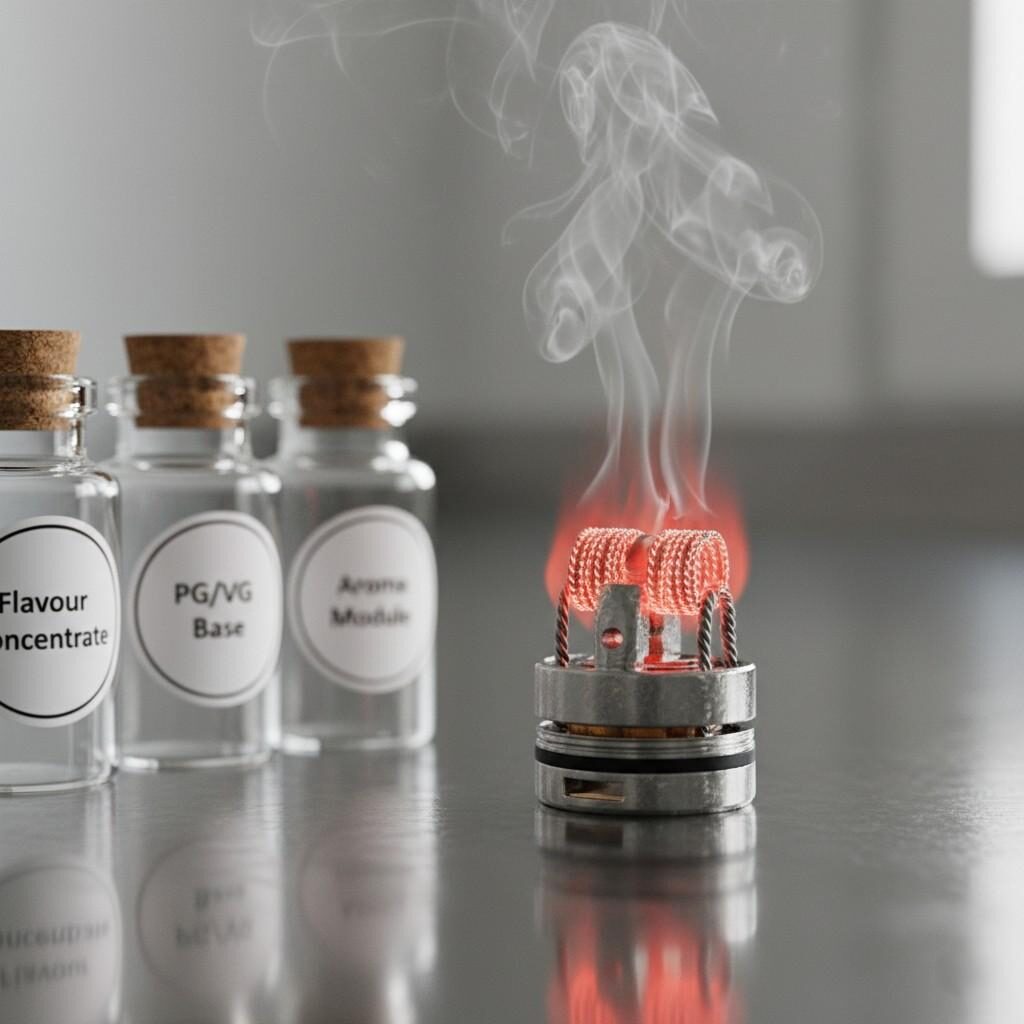Author: R&D Team, CUIGUAI Flavoring
Published by: Guangdong Unique Flavor Co., Ltd.
Last Updated: Nov 10, 2025

Hot Vape Coil and E-liquid Components
In the evolving world of e-liquid flavours, one issue continues to frustrate both formulators and end-users: flavour that tastes flat, muted, or lifeless when the user operates the device at high temperature or high wattage. As a manufacturer of food-grade fragrance and aroma systems for electronic liquids, it’s critical we understand why this occurs, what the underlying mechanisms are, and how we can design flavour systems that retain brightness, clarity and complexity even under high-temperature vaporisation conditions.
This blog post—“Why Does Your Flavor Taste Flat After High-Temp Vaporization?”—is designed to meet the Google user-intent of individuals searching for answers to flat/weak flavour in e-liquids under high-heat conditions (keywords like “high wattage e-liquid flavor muted”, “why flavour dull at high temp vaping”, “coil temperature flavour loss e-liquid”). We deliver clear, authoritative, structured information covering chemistry, device/flavour interplay, formulation guidance and quality control best practices.
Sections include:
By the end of this article you’ll be equipped to design, adjust and communicate flavour modules that perform robustly under higher wattage/temperature conditions, preserving the sensory impact and consumer satisfaction that drive repeat usage.
E-liquid typically consists of a humectant matrix (commonly propylene glycol [PG] and vegetable glycerin [VG]), nicotine (or nicotine salts), and flavour / aroma compounds. When the liquid contacts a heated coil, it transitions to an aerosol — numerous tiny droplets or vapour particles that the user inhales.
The device’s coil temperature, power, wicking rate, airflow, and e-liquid composition all impact how the aroma compounds volatilise, partition, and reach the user’s palate. A key finding: high power and temperature settings increased aerosol mass production but also elevated thermal degradation of matrix and flavour compounds.
From a flavour-house perspective, aroma compounds must (a) remain stable in the liquid matrix, (b) volatilise during heating in a controlled manner, (c) survive transit through the aerosol droplet/droplet-evaporation-inhalation path, and (d) deposit on the palate and retronasal pathways to deliver the intended sensory profile.
When everything runs well, the user perceives top-notes, mid-notes, back-notes, mouthfeel and aroma transitions. But the system is sensitive: thermal stress, high airflow, high temperature, rapid coil heating, depletion of liquid supply, or device mis-wiring can compromise one or more of these steps — resulting in perceptible flavour flattening, muting or off-notes.
In practice, “flat flavour” means the user reports: broad flavour impression is weaker than expected; selective notes (top, fruit, fresh) are lost; mid/back-notes dominate (or nothing dominates); the vaping session lacks brightness, clarity or “pop”.
Mechanistically, this may arise from:
Understanding these mechanisms helps us design flavour systems tuned for high-temperature conditions.
At higher coil temperatures or rapid ramp-up (high wattage), aroma compounds with comparatively low boiling or evaporation points can be excessively volatilised, evaporated too quickly, or evaporate before the user inhales. In effect, they are “burnt off” early or lost to the headspace rather than delivered in the aerosol.
On vaping forums, users frequently note that fruit and floral notes are especially vulnerable to heat:
“Another thing you might be experiencing is actual flavor loss… The volatiles are more susceptible to heat through evaporation.”
Therefore, flavour houses must consider volatility profiles of aroma compounds and how high-temp conditions alter effective delivery.
High coil temperatures (or over-power conditions) may promote decomposition of PG/VG matrix, increased carbonyl formation, and even reaction of flavour compounds with coil or wick materials. One study noted that when the device’s wick supply fails to keep up with vapour generation, the coil overheats and the e-liquid may degrade.
This thermal stress may:
High-temperature vaping often leads to larger volumes of vapour, faster evaporation, and possibly thicker droplets. That can result in:
Research shows that increasing voltage or power increases aerosol production but also increases thermal degradation products and may yield lower effective flavour transfer.
Since some aroma compounds are more thermally stable than others, high-temperature conditions can shift the relative proportions delivered to the user. For example: a highly volatile top-note compound may be lost entirely, while a more robust mid/back-note remains. The result: the flavour profile lacks top-note brightness, appears flat, and may lean heavy or one-dimensional.
As a flavour house, you must anticipate that when exposed to high-temp vaporisation the flavour map will shift, and design your modules accordingly.
Extraordinary device conditions exacerbate flavour flattening:
All of this plays into why a flavour-rich e-liquid may still taste flat when used on high-temp setups that were not anticipated at formulation.

Aroma Compound Loss in Vaping
As a fragrance/manufacturing partner to e-liquid brands, you should build flavour modules that account for high-temperature vaporisation. Key steps:
To guarantee performance, flavour houses should implement analytical workflows including:
Given the shift in delivered profile under high-temp conditions, flavour design needs to incorporate:
A flavour-house must recognise that flavour delivery still depends on device architecture. Collaborate with the brand or OEM to:
From a marketing and brand-support perspective, flavour houses should supply:
A frequent mistake: re-using a flavour developed for MTL/low-watt scenarios in a high-watt DTL setup without modification. Result: top-notes vanish, profile flattens. Avoid by segmenting flavour modules by device/power type.
Ignoring how end-user device conditions vary (coil ageing, airflow, maintenance) leads to inconsistent results and “flat flavour” complaints. Pro‐actively include worst-case device simulation in your testing.
Underestimating how flavour compounds degrade under high heat, or not monitoring for off-note formation (burnt, metallic, chemical) can harm brand reputation. Implement thermal stress and chemical breakdown analysis.
When flavour houses operate in isolation from brand/device contexts, flavour may not perform as intended on the platform the brand uses. Establish ongoing communication: coil specs, wattage ranges, airflow, user profile.
Even the best formulation may be misused if the consumer uses extremely high wattage, wrong coil resistance, or neglects maintenance. Provide user-care instructions as part of flavour packaging or technical sheet (e.g., “for best flavour use coil 0.4Ω at 55-65 W, airflow 40% open”).

Aroma Compound Retention Testing
Brand Z launches a sub-ohm DTL kit targeting 70-90 W usage. They want a fruit-cream dessert profile (“Tropical Bliss”) that maintains brightness and flavour depth even at high wattage.
✔ Map target device conditions (resistance, wattage, airflow) with brand client
✔ Select aroma compounds with volatility/thermal stability profiles suited for high-temp use
✔ Include retention/fixative modifiers in flavour modules to extend delivery across puff
✔ Run thermal/analytical aerosol tests replicating high-temp usage
✔ Conduct sensory panels in high-watt device conditions to validate flavour performance
✔ Provide dual-version modules (HT for high watt, LT for low watt) if brand’s portfolio includes both
✔ Supply technical datasheet to brand: recommended coil/resistance, wattage range, airflow, dosage, expected flavour profile result
✔ Educate brand’s end-user or provide usage notes to avoid mis-use (too high wattage, wrong coil) that leads to flat flavour
✔ Monitor post-launch feedback and adapt formulations for next iterations
When users complain that “my flavour tastes flat when I vape high wattage”, it’s not a matter of luck—it reflects a cascade of physical, chemical and sensory shifts triggered by high-temperature aerosol generation. As a flavour manufacturer in the e-liquid industry, you hold the keys to addressing that challenge: by designing aroma modules with high-temp resilience, collaborating with brands on device specs, undertaking analytical and sensory validation, and communicating best-practice usage.
Ultimately: excellent flavour performance at standard wattage is just the beginning. The flavours that survive and shine under high-temp DTL setups are the winners—delivering stronger consumer satisfaction, repeat usage and brand loyalty. By anticipating, engineering for and mitigating the flattening effects of high-temp vaporisation, your flavour systems become a differentiator for your brand-clients and their end-users.

Title: Flavor Collaboration in the Lab
At CUIGUAI Flavoring, we specialise in high-resilience aroma systems for electronic liquids, tailored for both low-wattage MTL and high-wattage DTL setups. We offer:
🌐 Website:[www.cuiguai.com]
💬 Whatsapp:[+86 189 2926 7983]
📩 Email:[info@cuiguai.com]
📞 Phone: [+86 0769 8838 0789]
Connect with us and ensure your flavour systems deliver full sensory impact—even under the most demanding high-temperature vaping conditions.
The business scope includes licensed projects: food additive production. General projects: sales of food additives; manufacturing of daily chemical products; sales of daily chemical products; technical services, technology development, technical consultation, technology exchange, technology transfer, and technology promotion; biological feed research and development; industrial enzyme preparation research and development; cosmetics wholesale; domestic trading agency; sales of sanitary products and disposable medical supplies; retail of kitchenware, sanitary ware and daily sundries; sales of daily necessities; food sales (only sales of pre-packaged food).
Copyright ©Guangdong Unique Flavor Co., Ltd.All Rights Reserved. Privacy Policy